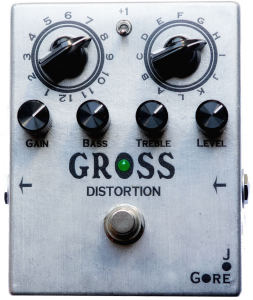AVAILABLE NOW FROM VINTAGE KING!
“Gross invites uncomplicated, impulsive sound shaping as much as it enables surgical tone sculpture. It’s hard to make a bad sound. The distortion tones have a rich, growling, and even-tempered essence that can be re-shaped easily with guitar volume and tone attenuation. Gross is highly responsive—to modifications from its own control set, from your guitar, or from your pick attack. Gore may have aimed for 156 tone ‘colors’ from the Gross. In fact, the real number of available tone shades is exponentially more. Now that I’ve tried it, I almost get anxious thinking about doing a recording session without it.” —Premier Guitar magazine
“One of the coolest distortion pedals I’ve heard. Delightful.” —Michael Beinhorn, producer (Red Hot Chili Peppers, Soundgarden, Aerosmith, Material, Hole, Ozzy Osbource, Marilyn Manson)
“Gross is a very useful, high-quality, and musical-sounding fuzz. It’s one of those fuzzes that never blats out — you can always hear all the notes in a chord through this thing of beauty. You know sometimes with other fuzzes you feel like, ‘Man, what a mess’? This is the opposite of that. There are 156 settings and they ALL SOUND GREAT! It’s a Swiss Army tone sculptor! Any guitarist interested in widening their palette live or in the studio should check this puppy out.”
—Teddy Kumpel, guitarist and producer (Joe Jackson, Rickie Lee Jones, Feist, Nine Inch Nails, Marshall Crenshaw, Paquito D’Rivera, solo artist)
“Gross is a freakin’ brilliant pedal. It’s insanely useful in my work as a TV/film/commercial composer, where anything I can do to streamline my process is crucial. Gross allows me to stay on the same guitar/amp set up and pretty much get all my sounds for the current track with just some tweaks of the pedal/guitar settings. I also love how it’s laid out — I just write my diode combo in the notes of ProTools in case I ever need to recall anything. Great stuff!”
—John Flannery, composer (UFC/MTV/VICE TV/Mattel/McDonalds) and session player (The School of Rock, Monster Magnet, Porno for Pyros)
There’s never been a distortion pedal quite like Gross—so it needs an explanation.
At its heart, Gross is a simple, one-transistor distortion from the same family tree as the Electra circuit. This simple yet powerful effect was built into Electra guitars in the late ’70s, and was later adopted by many boutique stompbox builders. For good reason: It’s a lively, dynamically responsive circuit with less compression than most modern IC-based distortion pedals. The transistor boosts the level, and then the signal hits a pair of clipping diodes, which provide the signature distortion.
Every diode combination sounds slightly different. In fact, several boutique pedal companies have based their businesses on creating Electra derivatives with slightly varied diode choices. (Just Google “Electra distortion clone.”)
Gross isn’t an Electra clone. I’ve changed parts and values for a fatter sound and even greater dynamic response. I also added an active 2-band tone control—something seldom, if ever, combined with primitive distortion like this. The distortion isn’t too “gainy.” It’s more about definition than sheer power—one reason it pairs well with other gain pedals. The character of your guitar and fingers always comes through.
The oddest feature is the diode section. Instead of a fixed diode pair, two 12-position rotary switches select from 24 diodes for 78 possible diode combinations! An additional switch adds a third diode for asymmetric distortion, which makes 156 possible shades. My target number was 144—that’s why I called it Gross (though that may have happened the other way around).
Some combinations are as different as night and day. Others are only as different as noon and 12:05. But this network of germanium, silicon, and LED diodes provides many crunch colors.
With its labeled and detented selector knobs, you can call up favorite settings onstage. But for me, Gross’s forte is as a studio tool. It’s great for “texturizing” guitar overdubs—just spin the dials till you find a tone that sits perfectly in the track. It’s especially useful for doubling.
Just one disclaimer: Like some other ultra-minimal gain circuits (I’m lookin’ at you, Z. Vex Super Hard On and Lovepedal Church of Tone), Gross can emit some crackle when the gain knob is rotated. It’s perfectly silent once it’s set — but if you think you’re likely to make major gain adjustments mid-performance, this could be an issue.
Gross Distortion was created in San Francisco and is built in Michigan by skilled craftspeople earning a fair wage. Available now from Vintage King.
TO USE: Set the desired gain and level. Grab the big knobs and start spinning. Toggle the +1 switch frequently for asymmetric distortion—the changes can be dramatic! When you hear a cool tone, refine it with the bass and treble knobs. (Note: the higher the gain setting, the more dramatic the diode-tone contrast.)
–Joe Gore, San Francisco
